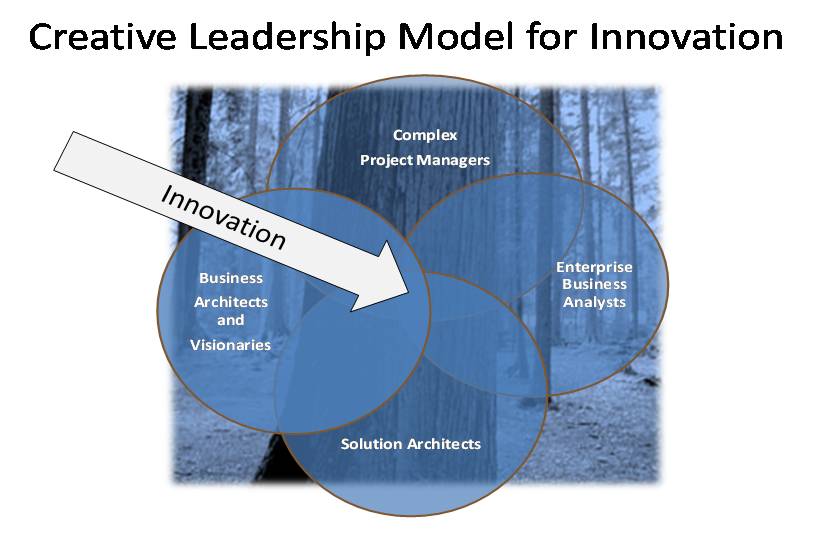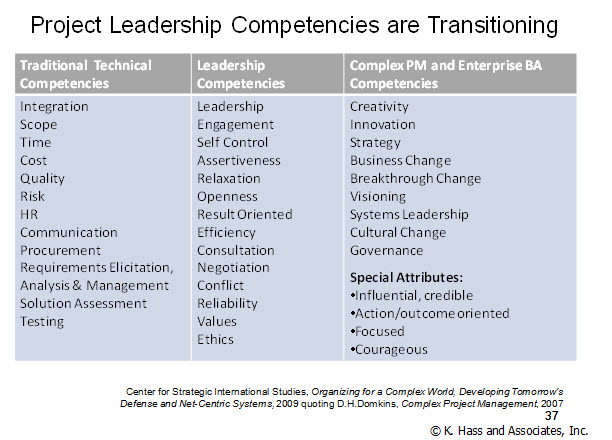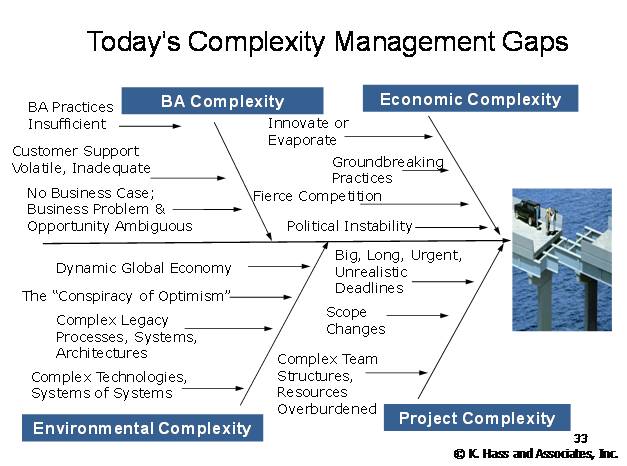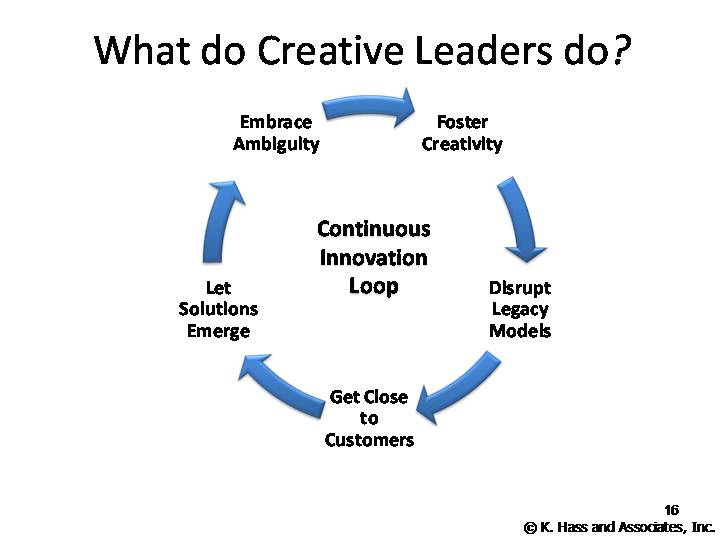NOTE: This article is part of "The 21st Century BA Series: From Tactical Requirements Manager to Creative Leader of Innovative Change"
In many organizations, culture and conventional wisdom make it difficult for the BA to break out of mostly tactical roles within projects. However, in many ways, the future competitiveness of your organization (and consequently of your future employment) depends on it! So don’t blink or you will miss out on the best BA opportunity of your career.
The Gale-Like Market Forces
In the first decade of the 21st century, as the profession of business analysis was just coming of age, the global economic crisis served as a wake-up call. According to Samuel J. Palmisano, Chairman, President and Chief Executive Officer, IBM Corporation, the most important findings from the IBM Global CEO Study were these: the biggest challenge CEOs are facing is the network of complexities brought about by the Internet and the global economy. The CEOs further stated that their organizations are not equipped to effectively manage this uncompromising complexity because they do not have the creative leaders that are needed.
What we heard … is that events, threats and opportunities aren’t just coming at us faster or with less predictability; they are converging and influencing each other to create entirely unique situations. These firsts-of-their-kind developments require unprecedented degrees of creativity — which has become a more important leadership quality than attributes like management discipline, rigor or operational acumen.[1]
The Impact for Business Analysis
What does this alarming level of complexity and the need for extraordinarily creative leaders have to do with the emerging discipline of business analysis?
-
If indeed, we are faced with a competitive and economic environment unlike anything that has come before; and
-
If enterprises today are not equipped to cope effectively with this complexity in the global environment; and
-
If business analysis is all about understanding the needs of organizations to remain competitive;
-
Then it seems as if a perfect storm is brewing that two new business disciplines are emerging to address: business analysis and complex project management.
Organizations around the globe are looking to the rise of a new leadership role, a strategic resource that, if used appropriately, can unleash the innovation and creativity needed to meet 21st century challenges. That new leadership role might well be filled by the enterprise business analyst, focused on business/technology optimization through innovative solutions.
The Forceful Winds of Change
Today, we struggle to demonstrate BA value while we operate in a web of organizational relationships and interconnected systems.
-
The emergence of the global economic and information network and the transition from labor-based to information-based organizations is marginalizing our traditional hierarchical structures, replacing them with often virtual sets of connections and partnerships.
-
Businesses are rejecting traditional management organizations to create complex communities comprised of alliances with strategic suppliers, networks of customers, and partnerships with key political groups, regulatory entities, and even competitors.
-
The pressure to perform is greater than ever, in the face of rising complexity and multifaceted and multilayered problems.
-
Business processes and supporting technology have become more interconnected, interdependent, and interrelated than ever before.
It is a challenging time, resulting in turmoil and disorder while companies are struggling to leverage the dynamics of the new economy: new business models, unprecedented change, unparalleled complexity, rapid innovation, and new leadership capabilities to convert strategic business needs into innovative products and services. Those who acquire and master enterprise business analysis capabilities will more effectively react to and pre-empt changes in the marketplace, capitalize on complexity, and flow value through the enterprise to the customer, thus remaining competitive.
Business Analysts Need to Learn How to Navigate New Business Models
Futurists predict the rise of “mass collaboration” as the new business model that will replace the prevalent corporate model. The traditional wisdom about how best to organize business is being rethought and reexamined. New forms of economic organization and a new science of management are emerging to deal with the breakneck realities of 21st century change. Our 21st century business models must be…”flexible, agile, able to quickly adjust to market developments, and ruthless in reallocating resources to new opportunities.”[2] It’s all about leadership vs. management, collaboration vs. hierarchy, and team vs. individual performance. Consider Exhibit 1, the new collaborative Creative Leadership Model for innovation.
So what does creativity look like in organizations? Creativity in organizations is about creative leadership — i.e., the ability to shed long-held beliefs and come up with original and at times radical concepts and execution. It requires bold, breakthrough thinking. This isn’t about having one or two lone creative leaders at the top, but rather, about creating a plethora of creative leaders, by igniting the collective creativity of the organization from the bottom up.[3] Who better than the enterprise BA to ignite collective creativity as she works with teams at all levels of the organization?

Exhibit 1: Creative Leadership Model for Innovation
Business Analysts Need to Learn How to Navigate Unprecedented Change
In the midst of this chaos, organizations are addressing the pressures of whirlwind change, global competition, time-to-market compression, rapidly changing technologies, corporate inertia, and yes, uncompromising complexity. Business systems and consumer products are significantly more complex than in the past; and for many reasons the projects that implement them are also exceedingly complex.
Not only are we facing systemic complexity, the very nature of change itself is changing. According to Jonathan Wilson, a consultant and owner of Anabasis Consulting, “It is happening not just more quickly, but faster than ever. It is happening in new ways with more turbulence, less predictability. The key cause of the changing of change in business is the acceleration of the flow of information and the exponential increase in the number of connections within and between organizations.” [4]
Business Analysts Need to Learn How to Manage – and Capitalize on – Unparalleled Complexity
Since we operate in a world that is substantially more volatile, uncertain and complex, CEOs share the view that incremental changes are no longer sufficient in a world that is operating in fundamentally different ways at Internet speed. Organizations are faced with an extraordinary combination of pressures to deliver increased revenue in traditional terms (added profits, avoided costs, lower taxes, higher productivity, less employee turnover, less risk exposure); and to constantly generate brand new revenue channels and sources of customer value to continue to thrive. They cannot rely on simply offering more of the same.[5]
According to the IBM report, winning CEOs and their teams are focusing on three transformational courses of action to capitalize on complexity.[6]
“The effects of rising complexity call for CEOs and their teams to lead with bold creativity; connect with customers in imaginative ways, and design their operations for speed and flexibility to position their organizations for twenty-first century success. To capitalize on complexity, CEOs:
Embody creative leadership. CEOs now realize that creativity trumps other leadership characteristics. Creative leaders are comfortable with ambiguity and experimentation. To connect with and inspire a new generation, they lead and interact in entirely new ways.
Reinvent customer relationships. Customers have never had so much information or so many options. CEOs are making "getting connected" to customers their highest priority to better predict and provide customers with what they really want.
Build operational dexterity. CEOs are mastering complexity in countless ways. They are redesigning operating strategies for ultimate speed and flexibility. They embed complexity that creates value in elegantly simple products, services and customer interactions.”
Business Analysts must Contribute to the Creation of Standout Organizations
A business that embraces the role of enterprise (strategic) business analyst to fill the void in creative leadership will produce the advances needed to become what is referred to as a standout organization, one that consistently delivers solid financial results even in economic downturns, has a revenue growth five or six times higher than their peers, and plans to get at least 20% of revenues from new sources. Standout organizations have learned how to consistently mitigate complexity and convert it to opportunity by:[7]
-
Navigating complexity superbly by tolerating change and adapting to it
-
Upsetting the status quo
-
Having confidence in their capabilities to prosper from complexity
-
Making decisions quickly, testing them in the market, and then making required course corrections
-
Pursuing iterative, ongoing strategy, requirements, and solution development
-
Reinventing their business analysis model often to adapt to learnings
-
Seeding creativity across their organizations.
Business Analysts Need to Learn How to Bring About Rapid Innovation
Competitive advantage is now coupled with an organization’s ability to rapidly innovate and to change products and systems quickly as the marketplace changes. Clay Christensen’s book “The Innovator’s Dilemma” documents the many examples of decades-old companies failing because they missed “game-changing transformation in industry after industry – computers (mainframes to PCs), telephony (landline to mobile), photography (film to digital), stock markets (floor to online) – not because of ‘bad’ management, but because they followed the dictates of ‘good management’.[8] Information technology (IT) has finally come into its own, and is now viewed as a critical component of innovation. Business change initiatives must not only deliver high quality products faster, better, and cheaper (traditionally the responsibility of the project manager), they are also under intense scrutiny to positively impact the bottom line (increasingly, the joint responsibility of the enterprise business analyst).
The strategy consultant Gary Hamel tells us that big companies fail “…not necessarily because they didn’t see the coming innovations, but because they failed to adequately invest in those innovations.” Hamel contends companies who control large pools of capital need to act more like venture capitalists. And workers at all levels will need to really feel a drive toward creativity and innovation.[9] One obvious example is Google. To foster innovation, Google engineers spend 20% of their time working on projects other than their current assignments – a practice enterprise BAs should follow.
Business Analysts Need to Acquire New Leadership Capabilities
In their quest to build the organizational capabilities to invest in innovation projects, organizations are slowly discovering that the core competency of business analysis must be elevated in importance. Most organizations have invested handsomely in IT systems to help operate the business and capture business intelligence about the marketplace. Over the last two decades, organizations have also embraced the practice of professional project management. However, businesses are just now beginning to understand the importance of BA leadership capabilities needed to convert strategic business needs into innovative products and services, to operate with speed and agility, and to try more disruptive approaches than ever before (see Exhibit 2, Project Leadership Competencies are Transitioning).

Exhibit 2: Transitioning Project Leadership Competencies
Business Analysts Need to Elevate Their Influence
Organizations are finally grooming and fielding more enterprise-focused business analysts, driving business analysis practice maturity from tactical to more strategic endeavors. Emerging enterprise business analyst roles include enterprise analysts, business architects and business/technology analysts.
-
Enterprise business analysts work to execute strategy through transformational change initiatives.
-
Business architects make the enterprise visible and ensure the business and IT architectures are in synch. Business architects create both the current- and the future-state architectures and work to identify the gap in capabilities needed to achieve the organization’s future vision.
-
Business/technology analysts convert business opportunities into innovative business solutions and translate strategy into breakthrough process and technology change.
All of these roles are enterprise focused, cross-functional and cross-domain experts who execute existing strategy and forge the next strategy. These three roles – the enterprise analyst, the business architect and the business/technology analyst – are the future creative leaders CEOs are making every effort to find. The hallmark of these strategic analysts is still understanding the business need, but fulfilling it, not through incremental change, but through game-changing innovation and creativity. Consider Exhibit 3 – BA Capability Model. Strive to move your focus areas of activity to the right to exert your leadership capabilities.

Exhibit 3: BA Capability Model
Business Analysts Need to Unleash their Creative Potential
Since there appears to be an insatiable demand for innovative products, services, business systems and supporting applications, executives across the spectrum are beginning to adopt the practice of superior business analysis to increase the value initiatives bring to customers and wealth to the business. As we begin to understand that the root cause of far too many failed and challenged projects is our inability to manage complexity to drive innovation (see Exhibit 4: Gap in Capabilities to Manage Complexity), we conclude that the talents, competencies, and heroics of project managers and technologists alone cannot drive innovation in these demanding times. BAs need to collaborate with PMs to close the gaps in complexity management to unleash creativity and innovation.

Exhibit 4: Gap in Capabilities to Manage Complexity
Business Analysts Need to See Themselves as a Corps of Creative Leaders
Creativity is the premier skill requirement for the innovation-focused leader. Creativity is defined as the ability to generate innovative ideas and concepts, and then producing something original and useful. The process involves original thinking and then “creating” – generating something new. There is never one right answer. According to creativity experts, “To be creative involves divergent thinking (generating many unique ideas) and then convergent thinking (combining those ideas into the best result).”[10] But even creativity is not enough; our competitive climate calls for us to be purposefully disruptive, to continually re-invent our business models and our products, to foster bold, breakthrough thinking.
Business Analysts Need to Understand What Creative Leaders do
The creative process calls for us to function when surrounded by uncertainty and ambiguity, by doing lots of experimentation, prototyping, out-of-the-box thinking, trial and error, and keeping options open until the last responsible moment. Top creative performers exhibit “an unusual visual perspective...an ability to synthesize diverse elements into meaningful products.”[11] The CEOs who participated in the IBM study stressed the relationship between integrity and creativity, the need for global thinking, and a strong focus on customers.[12] For BAs to mature the enterprise business analyst role into that of a strategic innovator, it is important to identify themselves as strategic thinkers early and groom themselves as quickly as possible to unleash enterprise creativity. What do creative leaders do? See Exhibit 5: Creative Business Analysts.

Exhibit 5: Creative Business Analysts.
Special attributes are required for business analysts to become innovation leaders and be able to defy complexity with creativity. They must be action and outcome oriented. They have to be focused and courageous. You will become a creative enterprise BA when you are doing these things:
-
Sharing the project leadership role with the project manager
-
Creating and leading innovative requirements integration teams
-
Influencing, swaying, and persuading groups and individuals to focus on creativity
-
Embracing uncertainty and ambiguity
-
Taking risks that disrupt legacy models
-
Rejecting traditional project management styles
-
Getting close to customers – bringing customers into the process
-
Using cost-benefits tradeoffs based on customer value
-
Insisting on innovation at every turn; not satisfied with business as usual; repeatedly asking, “Is this truly innovative, or just better business as usual?”
Putting it All Together: What Does This Mean to the Business Analyst?
Since the twenty-first century is rife with complexity, we need to learn how to leverage it – use it to our advantage. As the role of the business analyst transitions from a tactical project-focused resource to an innovation-focused strategic asset, our organizations will begin to capitalize on the complexity that often leaves us baffled, perplexed, and challenged. It is no surprise that two new important disciplines are coming to life in the 21st century and spawning new roles: the complex project manager (CPM) and the enterprise business analyst (EBA). As these disciplines mature, the CPMs and EBAs will form collaborative partnerships in their quest to defy complexity with creativity.
 The articles in this series are adapted with permission from The Enterprise Business Analyst: Developing Creative Solutions to Complex Business Problems by Kathleen B. Hass, PMP. © 2011 by Management Concepts, Inc. All rights reserved. The Enterprise Business Analyst: Developing Creative Solutions to Complex Business Problems
The articles in this series are adapted with permission from The Enterprise Business Analyst: Developing Creative Solutions to Complex Business Problems by Kathleen B. Hass, PMP. © 2011 by Management Concepts, Inc. All rights reserved. The Enterprise Business Analyst: Developing Creative Solutions to Complex Business Problems
 Hass.jpg) Author: Kathleen B. (Kitty) Hass, PMP, Senior Practice Consultant, Kathleen Hass & Associates, Inc.
Author: Kathleen B. (Kitty) Hass, PMP, Senior Practice Consultant, Kathleen Hass & Associates, Inc.
Kitty is the president of her consulting practice specializing in enterprise business analysis, complex project management, and strategy execution. She is a prominent presenter at industry conferences, author and facilitator. Her BA Assessment Practice is the gold standard in the industry. In addition to assessments, Kitty’s expertise includes implementing and managing PMOs and BACOEs. She has over 25 years of experience providing professional services to Federal agencies, the intelligence community, and Fortune 500 companies. Kitty is a Director on the IIBA Board and Chair of the IIBA Board Nominations Committee. She has also authored numerous white papers and articles on leading-edge business practices, the renowned series entitled, Business Analysis Essential Library, and the PMI Book of the Year, Managing Project Complexity - A New Model.
Email: [email protected]
Website: www.kathleenhass.com
Blog: http://baassessmentmatters.blogspot.com/
Twitter: @BA_Assessment @KathleenHass1
[1] Samuel J. Palmisano, Chairman, President and Chief Executive Officer, IBM Corporation in his letter accompanying the Global Chief Executive Officer Study of 2010, Capitalizing on Complexity. Online at: http://www-935.ibm.com/services/us/ceo/ceostudy2010/index.html (accessed July 2010).
[2] Alan Murray, The End of Management, The Wall Street Journal, Weekend Section, August 21 – 22, 2010. Adapted from: The Wall Street Journal Essential Guide to Management, 2010. New York, NY: Harper Business, an imprint of HarperCollins Publishers.
[3] Navi Radjou, Jaideep Prabhu, Prasad Kaipa, Simone Ahuja. May 19, 2010 How To Ignite Creative Leadership In Your Organization. Online at: http://blogs.hbr.org/cs/2010/05/how_to_ignite_creative_leaders.html (accessed July 2010).
[4] Jonathan Wilson, Anabasis Consulting. Online at: http://www.trojanmice.com/articles/noplans.htm (accessed July 2010).
[5] IBM, The Global Chief Executive Officer Study of 2010, Capitalizing on Complexity, Online at: http://www-935.ibm.com/services/us/ceo/ceostudy2010/index.html (accessed July 2010), 9.
[6] IBM, The Global Chief Executive Officer Study of 2010, Capitalizing on Complexity, Online at: http://www-935.ibm.com/services/us/ceo/ceostudy2010/index.html (accessed July 2010), 9.
[7] ibid
[8] Ibid.
[9] Ibid.
[10] Po Bronson and Ashley Merryman. The Creativity Crisis Newsweek July 19,2010, 45.
[11] Po Bronson and Ashley Merryman. The Creativity Crisis Newsweek July 19,2010, 45.
[12] IBM, The Global Chief Executive Officer Study of 2010, Capitalizing on Complexity, Online at: http://www-935.ibm.com/services/us/ceo/ceostudy2010/index.html (accessed July 2010), 9.